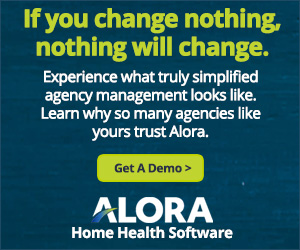
06 Jan Conquering Reimbursement, Billing & Coding Challenges in Home Health
Strategies for overcoming obstacles to efficient billing, reimbursement, and coding for home health care agencies
Home healthcare agencies’ administrative staff often grapple with unique circumstances that demand a specialized billing and coding approach. The intricacies of navigating insurance terminologies and optimizing coding processes can be overwhelming, leading to challenges in tracking potential reimbursement accurately. Therefore, striking a balance between comprehensive documentation and precise coding practices is paramount.
This article is intended to guide home health companies in boosting their income by providing insights into accurately submitting claims to insurance providers. The complexity of coding systems underscores the need for a more solid, and strategic approach. Home healthcare providers can ease the burden by leveraging technology to streamline processes and keep up with changes in reimbursement strategies
Policy Changes
Home health agencies face the challenge of dealing with different changes in Medicaid policies that have a direct impact on their reimbursement packages. This can cause a huge inconvenience for developers and higher management because it requires updated guidelines for coding, testing, maintaining, and deploying their systems.
Actionable Steps for Adapting to Policy Changes
Many agencies find it helpful to establish good relationships with local Medicaid offices, which allows them to find out information on policies quicker than most so that by the time they roll out the new policies, your company is already in compliance. Not to mention, it’s best to have a good working relationship with anyone you may potentially have to work with.
Documentation Accuracy
Managing treatment data by navigating through patients’ medical history, aligned with the procedures and requirements of the healthcare team, presents a complex challenge. Healthcare providers, each with their unique methods of tracking procedures, contribute to the intricacy of this task.
The inherent complexity is further intensified by the demanding nature of their roles, leading frontline staff to overlook crucial information potentially and adding to the complexity of their responsibilities.
Actionable Steps for Enhancing Documentation Accuracy
Many successful agencies have implemented dedicated documentation teams within their agencies that act as guides, aiding in the navigation of intricate situations by sharing vital tips and ensuring that everything is organized as it should be. Whether it’s a full team, or a skilled individual, having such a position or team in place proves to be a great benefit as everyone navigates through the formal reporting landscape, making all lives considerably smoother. Make sure your technology tools such as home care software, home health documentation software, and other solid digital platforms are in place to help your staff with some of the heavy lifting.
Coding Precision
Inaccurate coding in healthcare poses multi-layered challenges, particularly concerning reimbursement. One notable consequence is the increased likelihood of claim denials by insurance providers, resulting in delayed payments and heightened administrative burdens for healthcare entities. The misclassification of procedures, known as down coding, is another issue that leads to reduced reimbursement levels and financial strain on providers.
Actionable Steps for Enhancing Coding Precision
One key strategy many agencies have had massive success with is investing in comprehensive staff training programs that keep coding professionals informed of the latest coding guidelines and updates. Regular educational sessions on how to code can enhance their skills in accurate code selection, reducing the likelihood of errors. Additionally, leveraging advanced coding software and technology can streamline the coding process, improving efficiency and minimizing the risk of mistakes.
Billing Software Complexity
Billing software is like a double-edged sword—it comes with its own set of challenges. This is where billers and coders have to dive into intricate user interfaces and if they don’t know how to navigate it, it can be frustrating. It’s hard to accurately use a piece of technology that you’re not fully familiar with, so when agencies don’t take the time to train their staff on the software, it results in even more mistakes.
Actionable Steps for Addressing Billing Software Complexity
For agencies that have navigated this issue successfully, the secret lies in the presence of power users. Power users are individuals who have accurately navigated the intricacies of the software’s functionality. These power users, far from being exclusive tech experts, also serve as valuable resources for their colleagues. Whether it’s providing guidance or troubleshooting tech glitches, they consistently support their team. The noteworthy aspect is their commitment to knowledge sharing.
Audit Risks
The demand for accuracy in documentation and coding is a necessity, putting agencies under the watchful eyes of home health audit risks. Moreover, failed audits come with far more issues and consequences than a mere red mark on a report card. There are lots of problems that stem from this– Think claim denials, financial penalties—a hit to the wallet—and reputational damage. It’s about playing by the rules and making sure every single number and code in the healthcare world is perfect, avoiding the audit pitfalls that can disrupt harmony.
Actionable Steps for Mitigating Audit Risks
Some agencies have discovered a winning formula: the implementation of ongoing staff education programs. We know this has been a common theme throughout this article, but it’s really that important! This initiative serves as a mechanism to keep the team well-informed about the latest industry guidelines, ensuring that coding and documentation practices consistently meet the required standards.
This proactive stance signifies a commitment to continuous improvement in compliance. It’s akin to the agency proclaiming, “We’re not just present; we’re here to enhance ourselves daily.” With dedicated officers and regular training sessions, it creates a culture where adherence to regulations becomes second nature. It’s about ensuring that every member of the orchestra plays by the same rules.
The Takeaway
Upon grasping the intricacies of billing and coding language within home health agencies, one realizes that success exceeds the mere triumph over challenges. Instead, it involves embracing these challenges as invaluable stepping stones for learning and advancement within the field. The strategies explored, such as proactive employee training and the direct implementation of technology, serve not only to assist in tasks but also to unearth opportunities and bolster productivity.
As the healthcare industry changes, home health agencies are poised to encounter additional complexities and issues. Yet, their persistence and adaptability become key strengths, enabling them to grow even more robust. The assured maintenance of financial stability affords these agencies the ability to pledge exceptional standards of care. The success of home health agencies lies in their proactive approach toward challenges and ability to adapt to change, fostering resilience that ensures their ongoing success while ensuring the agency receives maximum reimbursement!
Author’s Note: Views, information, and guidance in this resource are intended for information only. We are not rendering legal, financial, accounting, medical, or other professional advice. Alora disclaims any liability to any third party and cannot make any guarantee related to the content.
Additional Home Health Agency blogs:

Alora’s home health software solution is ideal for agencies operating in both skilled and non-skilled care. When it comes to scheduling, documentation, billing, and compliance Alora offers an award winning solution that simplifies the administrative processes in the agency back office, while making patient care a thing of joy. When everything you need for every aspect of homecare is in one place, workflow is easier and patients can receive the best care.



No Comments